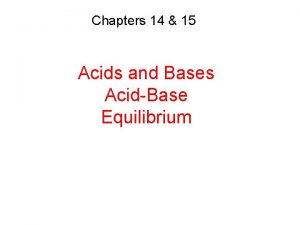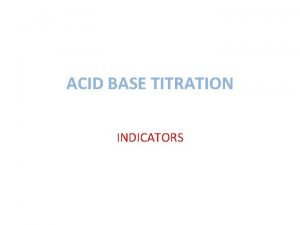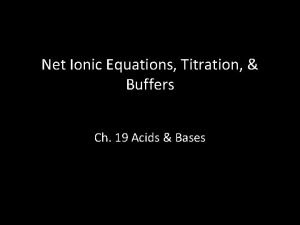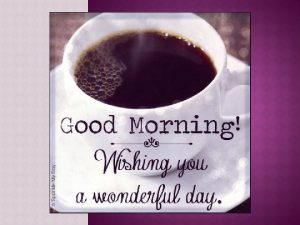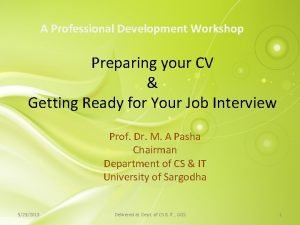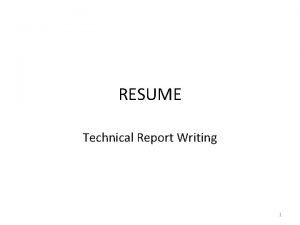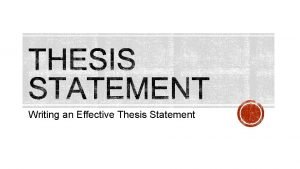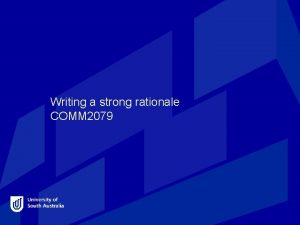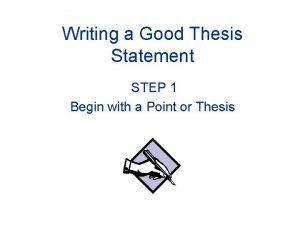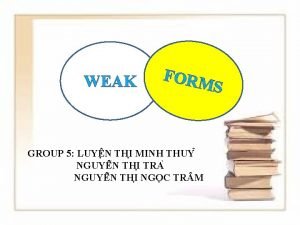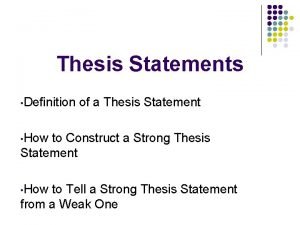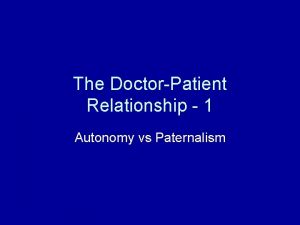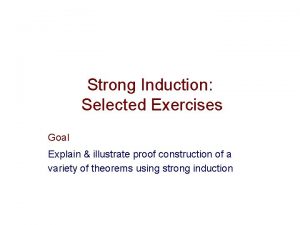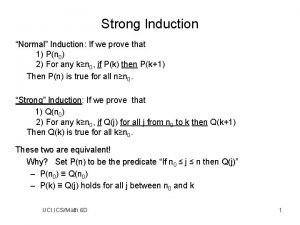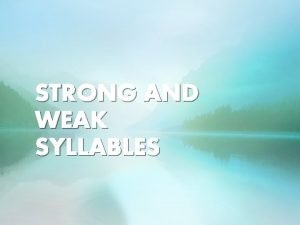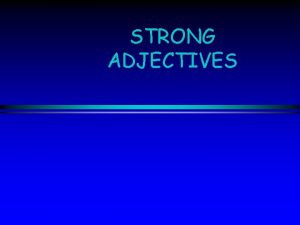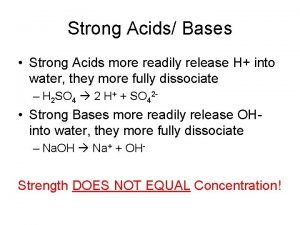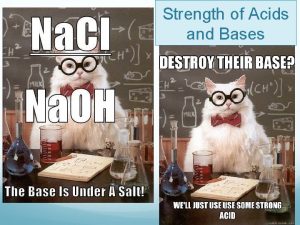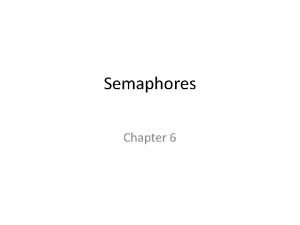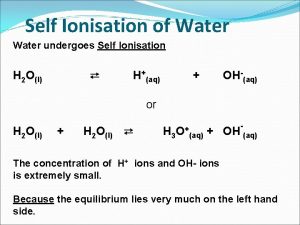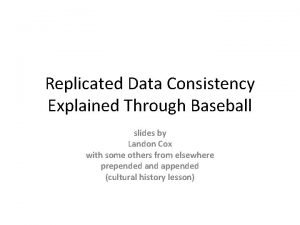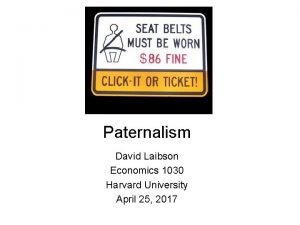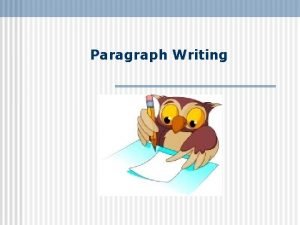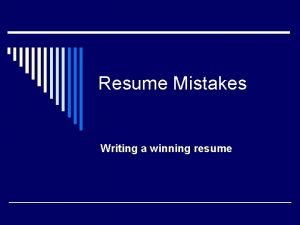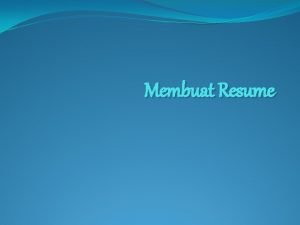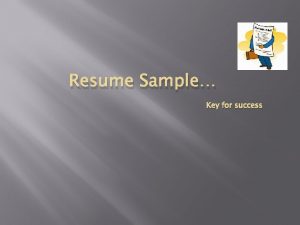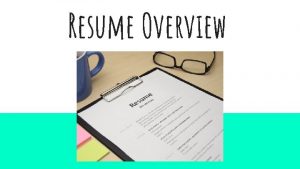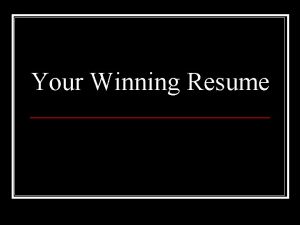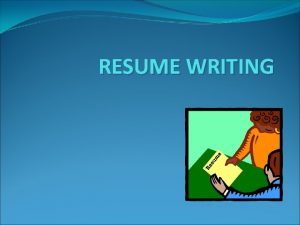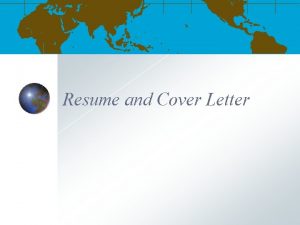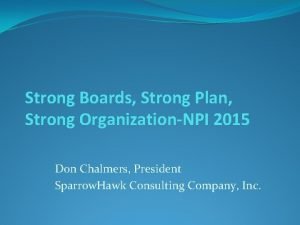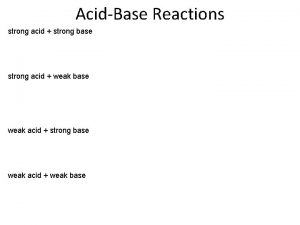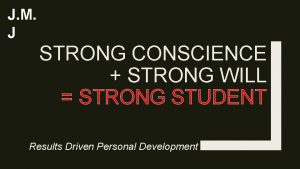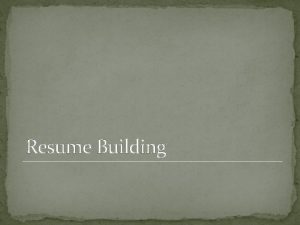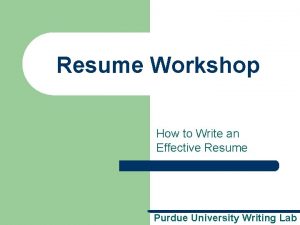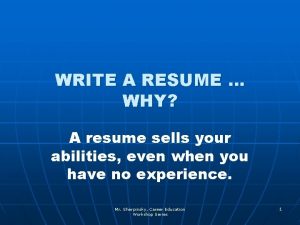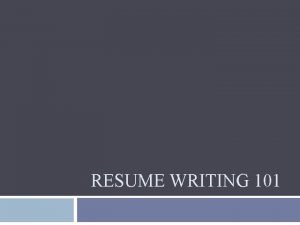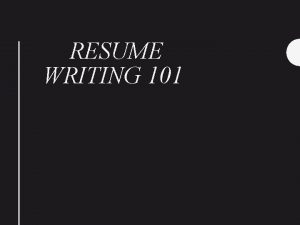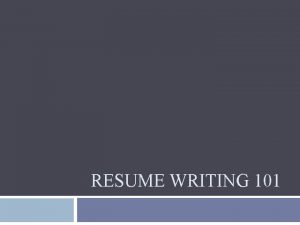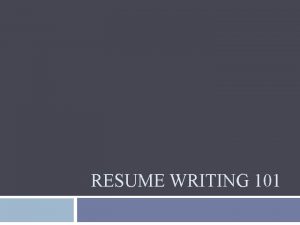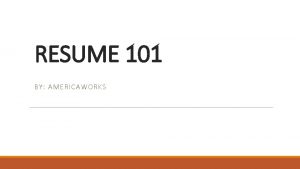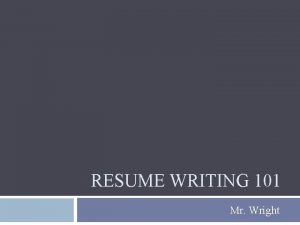RESUME 101 How to Write a Strong Resume






































- Slides: 38

RESUME 101 How to Write a Strong Resume

Hello! Please take the time to read over the Power. Point information to help you write/up-date your resume.

What is a Resume? • A resume is a compilation of your education, work experience, credentials and accomplishments. • Most jobs and professions require a resume as part of the hiring process. • It’s the first thing a recruiter or hiring manager will look at when reviewing job applications.

4 6 seconds Is the average time recruiters and hiring managers spend reviewing your resume before they make an initial decision.

RESUME STYLES 5

Resume Styles • There are several basic types of resume styles, each serving a different purpose. • The three most common ones are chronological, functional, combination.

7 Click here to read more about the different resume styles.

Chronological Resume The most common resume type. Lists your work experience in reverse chronological order, from the most to the least recent. 8

Functional Resume A functional resume only showcases you skills. No work history. Used by job seekers who are changing careers or have gaps in their employment history. 9

Combination Resume Lists your skills and experience first, then your employment history. As a student, a combination resume is deal. It combines both the chronological and functional resume styles. It showcases the skills you have that are relevant for the job you are applying for, while also providing your work history. 10

13 Sections to Include on your Resume

Header & Contact Info • First and Last Name • Mailing address • • • Phone Number (Use a larger text, but no larger than 20 -24 point size) (Professional email) Email address Linked. In (optional) 12

Objective (optional) • States your goals for employment. • Listed at the top of your resume. • • 1 -2 sentences long. • Clich here for more info & examples Some career experts say resume objectives are outdated and some say it’s still valuable.

Profile • • Alternate headings you can use: Overview, Summary • This section is at the top of your resume, under your name/contact info. • Click here for more info and examples This section of your resume lists a brief summary of your skills and experiences that are related to the position you are applying for.

15 The Profile can be written as a short paragraph like this:

16 Or it can be in bullet points like this:

Education You can add “Expected graduation ” “Relevant coursework ” is a list of courses that relate to the position you are applying to, otherwise you can leave out. 18

Work Experience • • • You can have two sections: one for work experience and one for volunteer/additional experience. If you have not yet accumulated much work experience, you can combine both work and volunteer experience under one heading – work experience. In this section you will list your work history. 19 Must include: Company #1 City, State Dates Worked Job Title • • • Responsibilities / Achievements Make sure to use accomplishment statements!!!

20

20

Certifications, Awards and Accomplishments 21 • List any certificates you have. • Mention any awards and achievements you have earned. Remember to include dates of when you received the awards in reverse chronological order.

Personal Interests 22 • If you have personal interests that strongly relate to the position you are applying for, list them. • This is helpful if you are applying for jobs where you don’t have a lot of related work experience, but experience achieved in other ways.

21 WHAT MAKES A GOOD RESUME

24 1. Use “Accomplishment Statements” • Showcase what you accomplished in each position rather than list your roles and duties. • Providing quantifiable (numerical) achievements help your resume STAND OUT. • Start your accomplishment statement with a action verb, there is no need to say “I managed…”, start with “managed…” • Video on how to write accomplishment statements

25 Salesperson Example: Rather than: Assisted customers with their purchases. Use: Exceeded retail sales goal by an average of 10% each month.

26 2. Take Time to Personalize it • • Personalize your resume to each job you apply for. Refer to the job posting and match what you write on your resume to the criteria the employer is seeking. Example: If you are applying for a manager role, your job history should reflect leadership roles and skills.

27 3. Make it Relevant What you exclude is just as important to what you include: • Your resume should reflect experience that is relevant to the job you are applying to. • Your resume should reflect experiences no more than 10 years in the past.

28 4. Format your resume Format : Infographic resumes are trendy in some industries (art/fashion/web design industries), but for most jobs it’s safe to use a traditional format; white page, black text, and legible font. Spacing : Keep it consistent Text: Use bullet points, headings, bolding, white spacing, and short, concise sentences. Avoid long sentences and chucks of text. Margins: even on all sides if possible

29 4. Format your resume Fonts : use basic fonts such as Ariel, Times New Roman, Calibri, Helvetica or Georgia. Font size : a) Name should be size no larger than 20 -24 pt. b) Subheadings should be no larger than 16 pt. c) All other text should be no larger than 12 and no smaller than 10. 5. Colour scheme : white background, black for letters and third color to emphasize headings/ highlight important parts.

30 Common Mistakes on Resumes

31 Mistake #1 : Not Proofreading Your Resume • Have someone proofread your resume for spelling and grammatical errors • Ensure to be consistent with verb tenses - Past work experience, use past tense verbs - Current work experience, use present tense verbs

32 Mistake #2 : Too Much Personal Information Don’t need to include: û û û profile picture Gender date of birth Nationality marital status

33 Mistake #3 : Employment Dates Without Months û ü 2009 -2010 June 2009 – Dec 2010 Don’t just write down the years, include the months so employers/recruiters don’t have to guess/question your work duration.

34 Mistake #4 : Does Not Show Accomplishments • • BAD: listing only your roles and responsibilities. • • Your resume is not a JOB DESCRIPTION. This does not show employers/recruiters what you have accomplished or how you were successful in that role. Ensure you are writing quantifiable achievements.

Mistake #5 : Including Irrelevant Work History • Do not need to include all of your work history, especially when it’s not relevant to the job you are applying for. • Keep your resume concise and to the point – they won’t want to read a 4 page resume.

Video Recommendations Videos about common resume mistakes from job recruiters: Video 1 Video 2 36

37 To succeed in today’s job market, think of your resume as an advertisement targeted towards your future employer.

38 Q 3 Assignment: • Please use the resume template provided to you in Teams to write an up-to-date resume. • Use the information and additional links in the slide to guide you. • Goal is to write some awesome accomplishment statements under each work experience position you have held!
 Ephesians 6 10-20 nkjv
Ephesians 6 10-20 nkjv Difference between strong and weak acid
Difference between strong and weak acid Strong acid strong base titration curve
Strong acid strong base titration curve How to remember strong acids and strong bases
How to remember strong acids and strong bases Acid base titration curve
Acid base titration curve What are strong bases
What are strong bases Net ionic equation for titration
Net ionic equation for titration Listen and match pretty shy good
Listen and match pretty shy good Strengths for resume
Strengths for resume Report writing resume
Report writing resume Karakteristik write through didalam write policy
Karakteristik write through didalam write policy H3po4
H3po4 Thesis statement example
Thesis statement example What is a rationale
What is a rationale Strong thesis statement
Strong thesis statement All strong acids
All strong acids Strong and weak forms of auxiliary verbs
Strong and weak forms of auxiliary verbs Strong ai vs weak ai
Strong ai vs weak ai 7 strong acids
7 strong acids 9-which acid is not considered a strong acid?
9-which acid is not considered a strong acid? Todo lo que el hombre sembrare
Todo lo que el hombre sembrare Strong thesis statement
Strong thesis statement Introduction paragraph hook examples
Introduction paragraph hook examples Deontology
Deontology Wizard lizard from superworm
Wizard lizard from superworm Proof that
Proof that Structural induction example
Structural induction example Weak syllables are
Weak syllables are Strong adjectives چیست
Strong adjectives چیست Strong acids and bases
Strong acids and bases Six strong acids
Six strong acids Elders housing preferences reflect a strong desire for
Elders housing preferences reflect a strong desire for Difference between strong and weak semaphore in os
Difference between strong and weak semaphore in os Ph 3 acid or base
Ph 3 acid or base Bitcoin
Bitcoin Pengertian lrs
Pengertian lrs Strong paternalism
Strong paternalism How long is a paragraph
How long is a paragraph Naval terms and phraseologies
Naval terms and phraseologies



